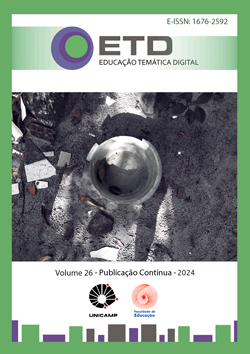Abstract
The Curriculum Document of the Maranhense Territory (DCTM) is a reference for schools located in Maranhense territory, with regard to the contents of the curricular components in basic education, specifically from kindergarten to elementary school. In this sense, the objective of this study is to discuss the structuring of the curricular component of Art in the document and also its relations with digital technologies. Thus, the concepts and foundations of the curriculum proposal for the territory of Maranhão are considered, with its approximations between education, technology and art teaching. This is the context of insertion of digital technologies in educational processes. Therefore, the method of document analysis was used to study the curriculum of Maranhão (DCTM), investigating how technological instruments are approached and indicated for the teaching of Art. The documentary study was based on theoretical references in the fields of art, education and digital culture. The results of the study indicated, mainly, a change in relation to the traditional curriculum of art teaching, which is justified by the need to integrate the technological apparatus into the didactic-pedagogical practice, with different technological-digital resources that, at times, perform the function of mediating instruments of pedagogical action and, at other times, they are means of access, creation and artistic expression in elementary school.
References
ALONSO, Kátia Morosov. Cultura digital e formação: entre um devir e realidades pungentes. In: CERNY, Roseli Zen et al. (org.). Formação de educadores na cultura digital: a construção coletiva de uma proposta. Florianópolis: UFSC/CED/NUP, 2017, p. 23-39.
BRASIL, Base Nacional Comum Curricular. Brasília. 2017. Disponível em: http://basenacionalcomum.mec.gov.br/ . Acesso em: 10 jan. 2019.
BRASIL, Lei de Diretrizes e Bases da Educação Nacional. LDB-9394-1996. Disponível em: http://portal.mec.gov.br/arquivos/pdf/ldb.pdf . Acesso em: 24 dez. 2021.
BARBOSA, Ana Mae. Dilemas da arte/educação como mediação cultural em namoro com as tecnologias contemporâneas. In: BARBOSA, Ana Mae (org.). Arte/educação contemporânea: consonâncias internacionais. São Paulo: Cortez, 2005, p. 98-112.
CASTELLS, Manuel. A sociedade em rede. Tradução de Roneide Venâncio Majer. 6. ed. São Paulo: Paz e Terra, 1999. 521 p.
KENSKI, Vani. Educação e tecnologias: o novo ritmo da informação. Campinas: Papirus, 2008.
LAPA, Andrea Brandão; PINA, Antônio Bartolomé; MENOU, Michel. Empoderamento e educação na cultura digital. Revista Educação e Cultura Contemporânea, v. 16, n. 43, abr. 2019. Disponível em http://periodicos.estacio.br/index.php/reeduc/issue/view/245. Acesso 12 abr. 2022.
LARUCCIA, Mario Maia. Notas sobre linguagem, comunicação e educação. Pensamento e Realidade, v.15. 2004. Disponível em: https://revistas.pucsp.br/pensamentorealidade/article/view/8446. Acesso 24 abr.2023.
LEMOS, André. Arte eletrônica e cibercultura. Revista FAMECOS, v. 4, n. 6, p. 21- 31, abr.1997. Disponível em: https://revistaseletronicas.pucrs.br/ojs/index.php/revistafamecos/article/view/2960 . Acesso: 24 junho 2021.
LÉVY, Pierre. Cibercultura. Tradução de Carlos Irineu da Costa. São Paulo: Editora 34, 1999.
MARANHÃO. Documento curricular do território maranhense: para a educação infantil e o ensino fundamental. Rio de Janeiro: FGV, 2019.
MILL, Daniel; JORGE, Glaucia. Sociedade grafocêntrica digital. In: MILL, D. (org.). Dicionário crítico de educação e tecnologias e de educação a distância. Campinas: Papirus, 2018.
MILL, Daniel; JORGE, Glaucia. Sociedades grafocêntricas digitais e educação: sobre letramento, cognição e processos de inclusão na contemporaneidade. In: MILL, Daniel. (org.). Escritos sobre educação: desafios e possibilidades para ensinar e aprender com as tecnologias emergentes. São Paulo: Paulus, 2013.
OLIVEIRA, Ana Cláudia Mei Alves de. Arte e tecnologia: uma nova relação? In: DOMINGUES, Diana (org.). Arte no século XXI: a humanização das tecnologias. São Paulo: Editora UNESP, 1997, p. 374.
PIMENTEL, Lucia Gouvêa. Tecnologias contemporâneas e o ensino da Arte. In: Inquietações e mudanças no ensino da arte. Organizado por Ana Mae Barbosa. 7. ed. São Paulo: Cortez, 2012.
PRENSKY, Marc. Digital Native, digital immmigrants. Digital Native immigrants. On the horizon, MCB University Press, Vol. 9, n.5, October, 2001. Disponível em: http://www.marcprensky.com/writing/Prensky%20%20Digital%20Natives,%20Digital%20Immigrants%20-%20Part1.pdf. Acesso em: 07 set. 2022.
POISSANT, Louise. Ser e fazer sobre a tela. In: DOMINGUES, Diana (org.). Arte e vida no século XXI: tecnologia, ciência e criatividade. São Paulo: Editora UNESP, 2003. p. 115-123.
SANTAELLA, Lúcia. Cultura das mídias. São Paulo: Experimento. 1996.
ZAMPERETTI, Maristani Polidori; ROSSI, Flávia Demke. Tecnologias e ensino de artes visuais – apontamentos iniciais da pesquisa. Revista Holos, v. 8, ano 31, 2015. Disponível em: https://www2.ifrn.edu.br/ojs/index.php/HOLOS/article/view/2031 . Acesso em: 3 jun. 2020.

This work is licensed under a Creative Commons Attribution-NonCommercial-NoDerivatives 4.0 International License.
Copyright (c) 2024 ETD - Educação Temática Digital


